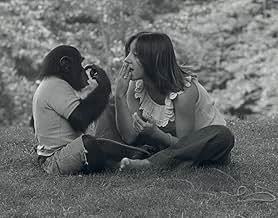Adicionar um enredo no seu idiomaTells the story of a chimpanzee taken from its mother at birth and raised like a human child by a family in a brownstone on the upper West Side in the 1970s.Tells the story of a chimpanzee taken from its mother at birth and raised like a human child by a family in a brownstone on the upper West Side in the 1970s.Tells the story of a chimpanzee taken from its mother at birth and raised like a human child by a family in a brownstone on the upper West Side in the 1970s.
- Indicado para 1 prêmio BAFTA
- 16 vitórias e 30 indicações no total
- Self
- (cenas de arquivo)
- Self
- (cenas de arquivo)
- Self
- (as Dr. James Mahoney)
- Self
- (cenas de arquivo)
Avaliações em destaque
There is a huge amount going on in this documentary as the carers over the years are interviewed with footage from the time. What emerges will probably anger and sadden most viewers. Though I felt that Nim's carers genuinely bonded with him what emerges is a largely a tale of careless cruelty.
Equally interesting and perhaps the root cause of what happens later is the relationships between the humans. Particularly between the project leader Professor Herbert Terrance and the numerous attractive research assistants. There are several references to the power he held and exercised. Overall it has to be said he does not emerge from this film as either likable or particularly competent.
The various approaches of the teachers and carers differ so widely and even though there is much happy footage you have to wonder at the effect this had on Nim. I was left with the feeling that he eventually responded best to the people who recognised him as a chimp but still treated him as a companion within the limits this imposed.
This is a powerful film that should be shown as widely as possible and would probably be good thing to included in school curricular.
The very idea of a chimp being brought up in human society is a fascinating one. But it quickly becomes apparent that this experiment is doomed to failure. There is a very good reason that you do not see people keep chimpanzees as pets – they can be extremely aggressive and powerful animals. On numerous occasions carers were bitten and maimed. One woman had a hole ripped in the side of her face while another had her head repeatedly beaten off the pavement by the ape. But the over-riding feeling engendered by the documentary is one of sadness. This poor creature is let down by those who took him from his mother and decided to rear him as a human. It seems to me quite outrageous that an animal taught to communicate with people and live in a house should ever have been sent to an animal experiment centre. The blame must surely be primarily put on Professor Herbert Terrace whose project it was. Once Nim was sent to a chimp reserve he seemingly lost interest and made absolutely no attempt to save him from what could have quite easily have been an awful fate. So thank heavens for Bob Ingersoll the man who looked after Nim in the reserve and never gave up on him. Bob ultimately saved him through perseverance and considerable effort. He emerges as the human hero of the film, although the other carers from New York such as Laura and the young couple who followed her also cared deeply for the animal too, the latter two still seemed genuinely pained by how Nim was ultimately treated.
The essential message of the film is that you should not try to transport a wild animal into human society and not expect repercussions. Some of the people in the film are just guilty of naivety, dangerous as it was. As much as a story about a remarkable primate, it's a story about human stupidity, human callousness and – thanks to Bob Ingersoll – human kindness. It's overall a remarkable documentary.
The movie is more about a team of people trying to salvage and place an off the track train back on it, when the damage was already done.
Sure it has a fascinating subject in the chimp Nim, but the more fascinating subjects are the humans who inhabit his life. From the professor who never saw Nim as any more than a subject. To the family who yearn to reconnect with him. And finally people who would rescue him from isolation. The camera really turns away from the animal back to all of us as a species.
Firstly, I do agree with the other reviewers comments on futility, I do not, however, agree entirely with Professor Terrace's view that the project was a failure, though conversely I do think the project failed Nim. To expand on this I would say that the conclusion of Terrace's failure seemed to fit a classic narrow set of parameters by which you compare and judge the outcome solely on an initial and highly specific expectation of what you will achieve. To this end perhaps it failed Professor Terrace's criteria.
I think however opportunities were certainly lost. Nim seemed to interact in so many subtle and fascinating ways during the process of his teaching, and he seemed to teach a great deal to all of the assistants who gave him their care. There seemed to be so little structure from the start with regards to what was to be taught and observed and in which direction the project should be going.
The only constant seemed to be the teaching of signing, at which Nim excelled! From what I could see, regardless of whether he learnt the actions to manipulate his handlers or not, he still learnt the signs. Since it was known that the chimp could not form human speech, how was it to communicate what it had learnt and why it was using the language in this way? I found this point frustrating and dubious and an example of one person with their eye so "firmly on the prize", that they miss the importance of the process.
Importantly, everybody who was involved across the duration of the project was given a chance to clearly state the turn of events. Perspectives on this varied widely, as you would expect, as everybody brought a different set of expectations and sensibilities, but it was a mature approach which I think led to the films balanced handling of Nim's story.
All in all I found it a fascinating cautionary tale. Luckily the balance of academic ego versus humanity that twists through this story left me with hope that indeed something had been learnt from the unique life of this Chimpanzee.
Você sabia?
- CuriosidadesVeteran primate choreographer and actor Peter Elliott actually met and worked with Nim Chimpsky when he was researching chimpanzees for Greystoke: A Lenda de Tarzan, o Rei da Selva (1984). He also met and worked with another famous signing chimp by the name of Washoe.
- Citações
Herbert Terrace: Wouldn't it be exciting to communicate with a chimp and find out what it was thinking? If they could be taught to articulate what they were thinking about, this would be an incredible expansion of human communication, and possibly give us some insight into how language, in fact, did evolve.
- ConexõesFeatured in Maltin on Movies: Harry Potter and the Deathly Hallows: Part 2 (2011)
- Trilhas sonorasCollide
Written by Autumn Rowe
Principais escolhas
- How long is Project Nim?Fornecido pela Alexa
Detalhes
- Data de lançamento
- Países de origem
- Central de atendimento oficial
- Idioma
- Também conhecido como
- Project Nim
- Locações de filme
- Empresas de produção
- Consulte mais créditos da empresa na IMDbPro
Bilheteria
- Faturamento bruto nos EUA e Canadá
- US$ 411.184
- Fim de semana de estreia nos EUA e Canadá
- US$ 25.820
- 10 de jul. de 2011
- Faturamento bruto mundial
- US$ 612.839
- Tempo de duração1 hora 33 minutos
- Cor
- Mixagem de som



























